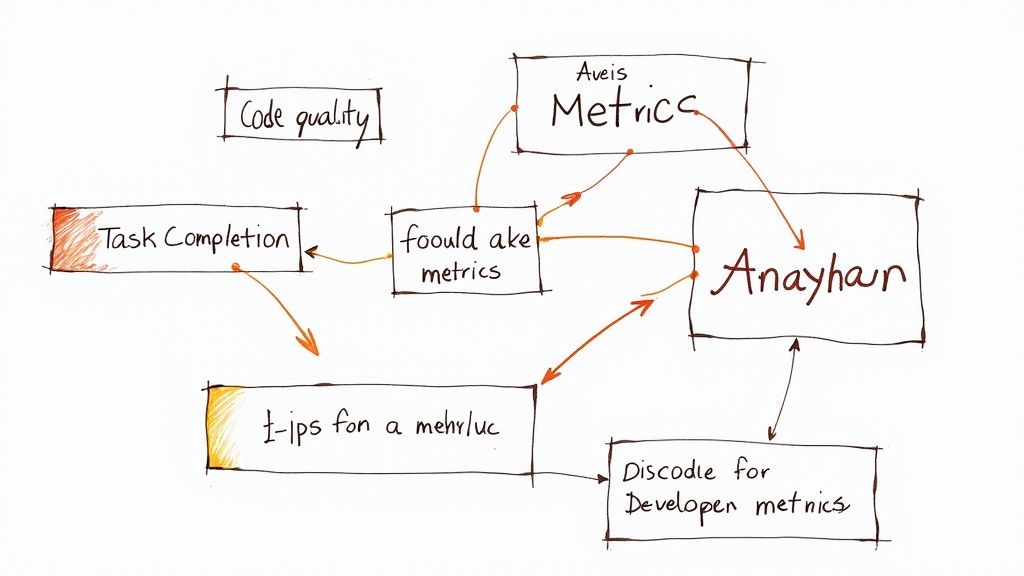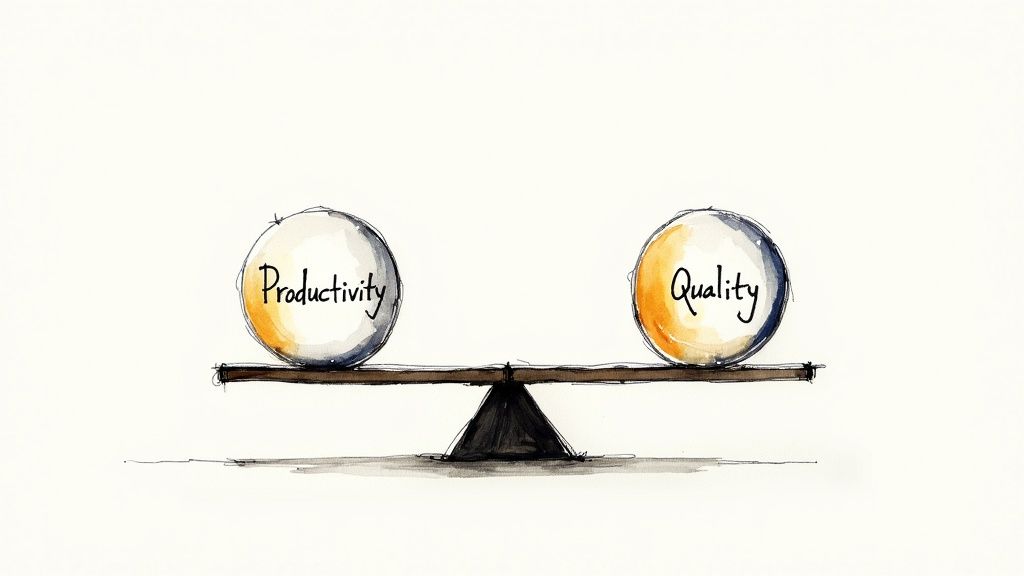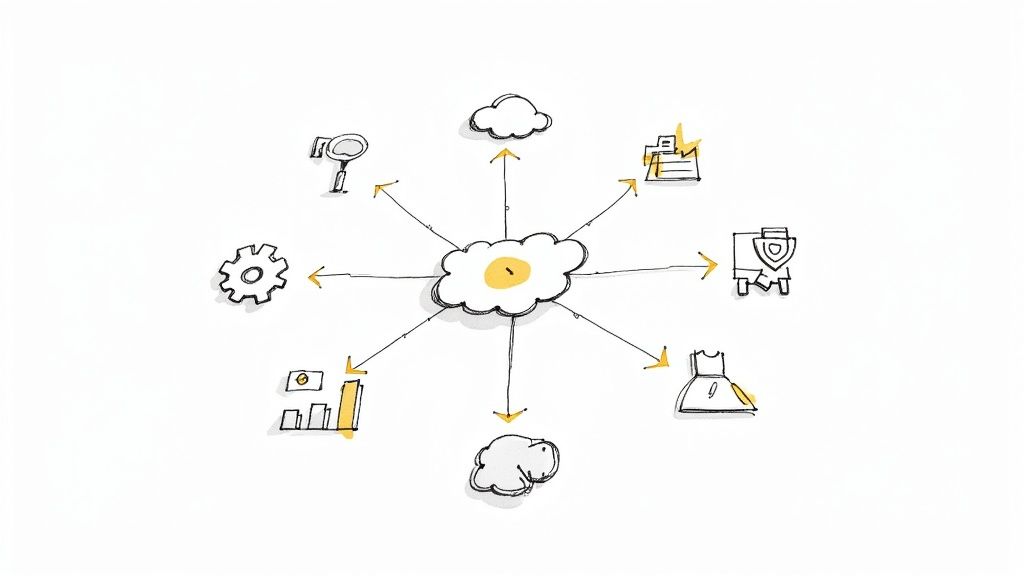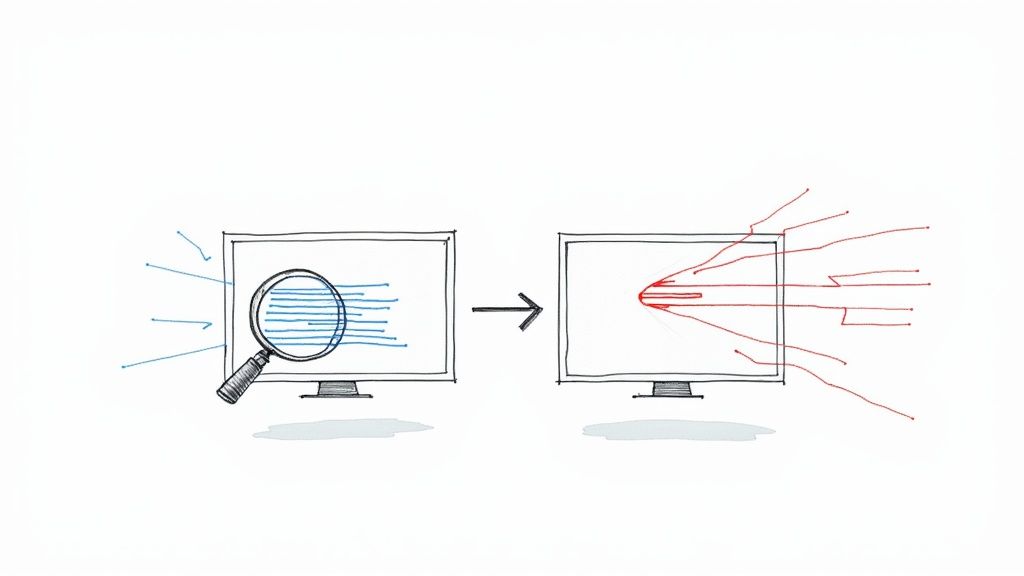Essential Developer Productivity Metrics: A Guide to Measuring Engineering Success

Understanding Core Developer Productivity Metrics

Measuring how well developers work is harder than it seems. Simple metrics like counting lines of code or completed tasks don't tell the whole story. The real challenge lies in understanding the actual value developers bring to projects and measuring outcomes that matter.
Key Metrics That Drive Success
The most useful performance indicators are ones that connect directly to business goals. Cycle time - how long it takes to complete work from start to finish - helps spot workflow bottlenecks. The number of bugs per feature shows where code quality needs work. But using these metrics requires careful thought about context.
Teams should also track deployment frequency - how often code goes live. More frequent deployments often mean faster feedback and better ability to adapt to user needs. This matters because quick, reliable software delivery helps teams stay competitive. For more insights on measuring developer work, check out this guide from Pluralsight on developer productivity metrics.
Moving Beyond Traditional Metrics
Old-school metrics like counting code lines or work hours miss important nuances. They can even encourage bad habits, like writing needlessly complex code or working long hours without results. Better options include measuring the real impact of features on users. This gives a clearer picture of what developers actually achieve.
Establishing Meaningful Baselines
Setting good baseline measurements helps teams track real progress. These baselines should fit your specific team and project rather than generic industry standards. Regular checks against your baselines reveal where processes are improving.
By focusing on your own team's progress instead of industry averages, you can find practical ways to work better without burning people out. This creates lasting improvements in both quality and team satisfaction. The key is measuring what matters for your situation, then making steady improvements based on real data.
Breaking Through Productivity Barriers

The first step to improving how developers work is finding what's slowing them down. This means taking a close look at daily workflows to spot areas that need fixing. Many teams discover that slow code reviews and poorly planned meetings are major roadblocks. These issues don't just slow down work - they can make developers frustrated and less motivated.
Common Productivity Roadblocks and Solutions
Teams often run into the same productivity challenges again and again. Here are some key problems and how to fix them:
- Context Switching: Moving between different tasks breaks focus and flow. Set aside blocks of uninterrupted work time and group similar tasks together to help developers stay in the zone.
- Unclear Requirements: When project details are fuzzy, developers waste time redoing work. Good documentation and open team communication can prevent this headache.
- Inefficient Code Reviews: Reviews that drag on too long create bottlenecks. Try using asynchronous reviews and tools like Mergify's merge queue to speed things up and let developers merge code faster.
- Meeting Overload: Too many meetings eat up coding time. Keep meetings short, plan them well, and use chat or email when possible to give developers more focused work time.
Teams can boost productivity by tackling these common issues head-on. One helpful tool is tracking weekly time loss - the percentage of work hours lost to problems like outdated tools or unnecessary meetings. For example, if a developer loses 20% of their time to excessive meetings, fixing that alone can lead to big improvements. Many teams now use time loss metrics to spot problems and improve their processes. Learn more about measuring developer productivity on GetDX's blog.
Building a Culture of Continuous Improvement
Real productivity gains come from consistent effort, not quick fixes. Teams need to regularly check and improve their processes, listen to developer feedback, and adapt as projects change. Regular team discussions about what's working and what isn't can highlight opportunities to work smarter.
Using good tools for testing and deployment helps too. When routine tasks are automated, developers can focus on solving problems and writing code. This speeds up development and catches issues early. But the key is building a team culture that values steady improvement - this creates lasting productivity gains and makes developers happier at work.
Maximizing Developer Productivity with AI Tools

AI tools have proven their worth in helping developers work more efficiently - not by replacing them, but by handling repetitive tasks and freeing up time for complex problem-solving. Getting real value from AI requires picking the right tools and measuring their impact effectively.
Choosing the Right AI Tools for Your Team
Finding success with AI means selecting tools that solve specific problems your developers face and work smoothly with your existing processes. For example, smart code completion can speed up routine coding, while automated testing frees developers to tackle harder challenges.
Here are the key types of AI tools to consider:
- Code Completion and Generation: Tools like GitHub Copilot help developers write code faster by suggesting snippets and completing functions
- Automated Testing and Debugging: AI can create and run tests automatically, catching bugs early. Mergify adds value here by automating code integration and testing
- Code Review and Analysis: AI tools can spot potential issues, style problems, and performance bottlenecks during code reviews
The goal is to have AI enhance your workflow, not disrupt it.
Measuring the Impact of AI on Developer Productivity Metrics
Once you've added AI tools, tracking their impact is crucial. Focus on metrics that show clear value:
- Code Completion Rate: Track how often developers use and accept AI code suggestions
- Time Saved: Measure the hours saved through AI automation of testing, debugging, and coding tasks
- Bug Detection Rate: Compare bugs found by AI tools versus traditional methods to see quality improvements
These numbers help prove the value of AI investments and show where to improve. Many teams are finding success with AI - for instance, Betterworks reports major efficiency gains from using AI tools to write tests and optimize code. Learn more about these approaches on Typo's blog.
Training and Adoption Strategies
Getting the full benefit of AI requires good training and team-wide buy-in. Provide clear documentation, run hands-on workshops, and offer ongoing help so developers can use the tools effectively. Create an environment where people feel comfortable experimenting with AI and sharing what works best. When teams collaborate on implementing AI tools properly, they see lasting improvements in how much they can accomplish.
Creating a Data-Driven Engineering Culture

Every engineering team wants to improve, but measuring progress takes more than collecting random data points. The key is thoughtfully using developer productivity metrics to understand your team's work patterns and pain points. When done right, metrics help teams spot opportunities for improvement. When done poorly, they create stress and resistance.
Introducing Metrics Effectively
Getting team buy-in starts with clear communication about goals and expectations. Take time to explain why you're measuring specific things and how you'll use that information. For example, if you track code review time, make it clear that the goal is finding process bottlenecks, not pressuring reviewers to rush. Being upfront builds trust.
Your developers should help choose which metrics matter most. They know their work best and can identify the most meaningful measurements. When teams help define success metrics, they're more invested in using them. Skip the top-down approach and make it collaborative.
Balancing Quantitative and Qualitative Data
Numbers tell part of the story, but qualitative insights complete the picture. Regular check-ins and developer surveys reveal crucial context behind the metrics. For instance, if bug counts spike, conversations might show that unclear specs or limited testing resources are the real culprits - not poor coding.
This is why you need both types of data working together. Use metrics to spot trends and issues, then dig deeper through discussions to understand root causes. Tools like Mergify can help by automatically analyzing pull requests and merges to highlight workflow problems that need attention.
Using Metrics to Drive Positive Change
The goal of tracking metrics is supporting teams, not micromanaging them. Focus on setting realistic targets and celebrating progress. Even small wins deserve recognition since they reinforce good habits and keep teams motivated to improve.
Let data guide your decisions about tools, processes, and resources. When teams see metrics leading to meaningful changes that make their work better, they'll embrace the data-driven approach. This creates a healthy cycle where measuring progress feeds continuous improvement, making development smoother and more satisfying for everyone.
Building Sustainable Measurement Systems
Creating an effective system to track developer productivity takes thoughtful planning and regular refinement. Success comes from building processes that provide real value without burdening your team with extra work. The key elements include choosing the right tools and metrics, developing clear reporting practices, and maintaining developer privacy.
Practical Approaches to Data Collection
Good measurement starts with reliable data collection that fits naturally into how developers work. Tools like Mergify can automatically track pull requests, merges, and code reviews as part of the normal development flow. This hands-off approach helps ensure accuracy while respecting privacy. For sensitive metrics, anonymizing the data helps build trust and protect individual developers.
Automating Analysis for Actionable Insights
Raw data only becomes valuable when transformed into clear insights teams can act on. Automated analysis tools that generate reports and visualizations save significant time compared to manual data compilation. This frees engineering leaders to focus on interpreting trends and identifying improvements. For example, automated reports showing code review completion times can quickly highlight bottlenecks slowing down development.
Reporting Strategies That Drive Meaningful Improvements
How you present metrics shapes how teams receive and use them. Reports work best when they are clear, focused, and tied to specific actions. Visual elements like charts help teams spot patterns and trends more easily. As an example, tracking value-add capacity over time through a dashboard clearly shows whether process changes are having the intended impact. Focusing reports on concrete areas teams can improve, such as reducing meeting overhead or streamlining reviews, helps drive real positive changes based on the data.
Avoiding Common Pitfalls
Several common mistakes can limit the effectiveness of productivity metrics. One is focusing only on numbers while ignoring qualitative developer feedback that provides essential context about root causes. Another risk is using metrics to monitor individual performance, which breeds distrust. Instead, use the data to understand team-level patterns and opportunities. Finally, failing to update your measurement approach as teams evolve leads to stale, irrelevant insights. Regular refinement of metrics and reporting keeps them aligned with current needs and goals.
The Future of Developer Productivity Measurement
Understanding how we track and improve developer productivity continues to change as teams adapt to new tools, practices, and ways of working. Here's what successful engineering teams are focusing on to build better development environments and deliver more value.
The Rise of AI-Powered Measurement
Artificial Intelligence (AI) is reshaping how teams analyze developer productivity data. Modern AI tools go far beyond basic code suggestions - they can now examine complex patterns across entire projects to spotlight meaningful insights. For example, these tools help teams identify slow code reviews, find where developers get stuck on low-value work, and catch potential delays before they derail timelines. This deeper analysis helps teams solve problems proactively rather than reactively.
Focusing on Value Delivery and Business Outcomes
Forward-thinking teams are moving away from tracking shallow metrics like lines of code or commit counts. Instead, they measure what truly matters - delivering real business value. This means tracking how new features actually impact user satisfaction, adoption rates, and key business metrics. By connecting development work directly to business goals, teams can focus their efforts on the changes that drive meaningful results.
Embracing Holistic Developer Experience Metrics
Traditional productivity tracking often misses a crucial factor - the human element of software development. Teams are now paying more attention to developer satisfaction, team dynamics, and sustainable work practices. When developers feel engaged and supported, they write better code and collaborate more effectively. Regular team surveys and retrospectives, combined with quantitative data, provide a more complete picture of team health and productivity.
The Need for Adaptable Measurement Systems
Static measurement approaches quickly become outdated as development practices evolve. Successful teams use adaptable measurement systems that grow and change with their needs. This requires regularly reviewing which metrics still provide value, testing new approaches, and adjusting based on team feedback and changing project requirements.
To help manage modern development complexity and improve your team's effectiveness, consider a tool like Mergify. Mergify helps streamline workflows, maintain code quality standards, and reduce CI costs - key factors in building a more productive engineering team.





